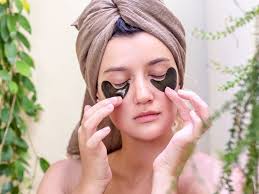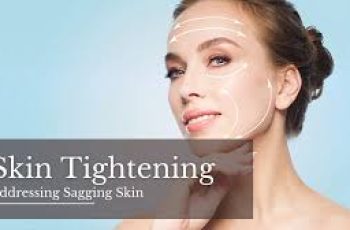
Dark Circles Under the Eyes- Causes and Treatment
Many people complain of dark circles under the eyes that make them appear tired, aged or unhealthy. As a dermatologist, I frequently see patients concerned about these shadows or discoloration under their eyes. The medical term for dark circles is periorbital hyperpigmentation (POH). Let’s look at what causes POH and the various treatments available. The first and best treatment for dark circles is to wear sunscreen and a skin lightening eye cream or serum.
Treatments for Dark Circles Under the Eyes
There are many different eye masks, creams and serums to get rid of darkness under the eyes. These work the following ways:
Provide sun protection
Reduce inflammation
Skin Lightening
Block melanin production
If you take the skincare routine quiz, we can help you build a custom skincare routine for your Baumann Skin Type.
Eye Creams and Serums
Using specialized eye creams, serums with skin lightening and brightening ingredients can go a long way toward improving dark circles. Most of the best eye treatments for dark circles target both discoloration and inflammation and have light reflective ingredients to reflect light and make the circles appear improved. Some also have a tint that functions as a concealer.
Look for products containing:
Tyrosinase inhibitors
PAR-2 blockers
Vitamin K
Antioxidants
Anti-inflammatories
Some of the best ingredients in eye creams to lighten the under eye area are:
Azelaic Acid
Cysteamine
Kojic Acid
Niacinamide
Retinol
Vitamin C
Niacinamide is excellent for calming inflammation and preventing pigmentation while kojic and azelaic acid work to inhibit melanin production. Retinoids like retinol are exfoliants and increase collagen production to strengthen delicate skin.
One of the best all around eye cream for dark circles is Replenix Brightening Eye Cream. It has the hydrating humectants hyaluronic acid and sodium Pca, antiaging retinol, and antiaging peptides. Most importantly for skin lightening- it has Vitamin C. It also has two other important ingredients to treat dark eye circles: Vitamin K and Arnica.
This is the best eye cream for men with dark circles because it has all the ingredients and hydration and antiaging you need without a feminine fragrance or tint.
It comes in a tinted version if you prefer some coverage.
Skin Lightening Eye Creams and Serums
The best dark circles under the eyes treatment is an eye cream or serum with skin lightening and brightening ingredients. Here are some of my favorites that I recommend to my patients.
[[E02]]
caffeine
Caffeine in Eye Treatments
Caffeine is a vasoconstrictor that constricts visible blood vessels when applied topically. This minimizes shadows and darkness. Caffeine also improves microcirculation and drainage for less puffiness and edema. Caffeine is also an antioxidant.
This eye cream targets aging skin in menopausal women by combating loss of estrogen. It also has caffeine which helps with hyperpigmentation, neutralizing free radicals and improves puffiness. This eye crem is not for men.
ISDIN Isdinceutics Vital Eyes has soothing ingredients and hydrating ingredients. In addition to caffeine- it has licorice extract which target both inflammation and dark circles.
Filorga NCEF-REVERSE EYES Supreme Multi-Correction Eye Cream has caffeine, amino acids, peptides and licorice extract. This eye cream has a strong feminine fragrance and is not for people with sensitvi eeyes and fragrance allergy.
La Roche-Posay Pigmentclar Eyes is one of my favorite eye creams to treat dark circles because it has niacinamide, caffeine, and ferulic acid.
hyaluronic acid
Hyaluronic acid and Humectants
Humectants like hyaluronic acid and other glycosaminoglycans pull water into the skin and plump it up. This reflects light more evenly for improved appearance. The results are temporary. Aging skin loses glycosaminoglycans needed for water retention so replacing them is key in older skin and dry skin types. Many eye creams have hyaluronic acid in it. The Replenix Brightening Eye Cream mentioned above has glycerin, sodium Pca and hyaluronic acid.
SENTE Illumine Eye Cream is a great eye cream to treat dark circles and dry skin and wrinkles in the eye area. It is the only eye cream with heparan sulfate. It also has niacinamide to prevent pigmentation, hydroxyacids to exfoliate, peptides to smooth wrinkles, and many humectants.
Eye Masks and Patches
Eye mask and patches use occlusion to “slug” ingredients into the skin. Any ingredients penetrate into the skin better when applied in or under an occlusive mask or patch.
Avoid patches if you have an allergy or sensitivity to adhesives.
[[E08]]
Sunscreen for Eye Area
Using broad spectrum SPF is vital for preventing UV damage and hyperpigmentation from increasing melanocyte proliferation. Choose mineral sunscreen with titanium dioxide and zinc oxide rather than chemical sunscreen in the sensitive eye area- especially is you get stinging eyes. Tinted eye sunscreens are particularly helpful for covering dark circles. Iron oxide pigments in tinted eye SPF provide additional light dispersion, coverage, and protection from blue light. (Blue light from phones and computers can worsen POH.)
One of the best eye creams with sunscreen to treat under eye circles is Neocutis LUMIERE FIRM Illuminating & Tightening Eye Cream. This eye brightening cream is to be used in your morning skin care routine to help block sun exposure to the delicate eye area.
You can also choose to layer an eye sunscreen over another eye cream in your skin care routine. These are good sunscreens for the eye area.
Tinted Eye SPF
[[S19T]]
Untinted Eye SPF
[[S19]]
cosmetic procedures
Cosmetic Procedures
Certain cosmetic dermatology procedures can also improve the appearance of dark under eye circles dramatically. However, you must avoid sun exposure after any of these or these procedures can actually cause post inflammatory hyperpigmentation which makes POH much worse than when you started!
Chemical Peels
Light 30% salicylic & lactic acid combination peels remove pigmented epidermal layers while stimulating new collagen growth in upper dermis for smoother, thicker, brighter skin. Improvements are seen faster than retinoids but require regular maintenance and most be used very cautiously in skin of color to avoid post inflammatory hyperpigmentation. Prices range from $100- $250 per peel.
Laser Treatments
Using optimized parameters, vascular lasers like long-pulsed 1064nm Nd:YAG combined sequentially in the same session with pigment-targeting Q-switched 532nm/1064nm Nd:YAG lasers attack shadows from blood vessels and melanin respectively. Multiple sessions are required for substantial lightening. Prices range from $300- $600 a session.
light treatments
Light Treatments
By emitting high energy visible light to target melanin and hemoglobin, IPL achieves mild skin tightening and erythema reduction to lessen vascular-type POH shadowing. Pigmentation and telangiectasias improve over a series of treatments. There is minimal downtime but the results are less dramatic than lasers for moderate dark circles.
Dermal Fillers and PRP
Dermal fillers containing hyaluronic acid effectively fill tear troughs and shadowed grooves. Plasma enriched platelet-rich fibrin matrix injections (PRP) stimulate localized new collagen formation. Effects of fillers and PRP last 6-12 months typically requiring maintenance. Fillers require one treatment an estimated cost of $300- $800. PRP may require a series of treatments. Costs are about $300- $600 per treatment.
I personally think that in my patients, topical eye creams and serums work better than fillers and PRP for most types of dark circles under the eyes. Fillers and PRP should only be used when the under eye darkness is due to hollowness and loss of fat under the eyes.
Blepharoplasty Surgery
If extra fat, loose muscle or excess skin is causing shadowing due to anatomical issues, an eyelid lift (blepharoplasty) can remove and reposition tissue for a smoother transition between the eyes and cheeks. This surgery addresses under eye hollowness for a more refreshed, wide awake expression. Recovery takes a few weeks.
causes of dark circles
Causes of Dark Circles under the Eyes
There are many things that can cause dark circles. Although it can be a sign of illness such as liver disease or cancer, this is unlikely. Dark circles are most often caused by inflammation, habits such as smoking and vaping, sun exposure, fatigue, and genetics.
Illness, Allergies, and Eczema
Having certain illnesses like anemia, eczema or dermatitis around the eyes can lead to post-inflammatory hyperpigmentation and irritation that darkens the thin skin. Atopic dermatitis and related eye rubbing/pruritus are common associations with POH. Allergies like hay fever cause blood vessel engorgement and venous stasis, allowing blood byproducts to accumulate in the skin. Asthma medications like prostaglandins can also cause periorbital changes.
Allergic Shiners
An extremely common cause of dark under eye circles is something called allergic shiners. These darker shadows are caused by nasal allergies, hay fever and environmental irritants leading to repetitive rubbing and irritation of the delicate thin skin around the eyes. Allergic shiners occur when the blood vessels around the eyes become engorged and wider in response to allergy-induced inflammation and histamine release.
The face has what are known as “allergic triangles” – areas more susceptible to itching, swelling and subsequent skin damage in individuals suffering from eczema, atopic dermatitis and seasonal or pet allergies. The skin around the eyes is one of these vulnerable zones. Darkening from allergic shiners can persist for days or weeks after the allergen exposure ends and often worsens with eye strain, lack of sleep or fatigue. Topical hydrocortisone creams may provide some relief. Ensuring adequate hydration and minimizing rubbing promotes healing of the sensitive periorbital skin.
dark circles from sun exposure
Sun Exposure
Exposure to UV radiation leads to increased melanin production, melanocyte proliferation and migration of melanosomes. This hyperpigmentation and free radical damage exacerbates POH.
Sunscreen must be used to prevent recurrence of under eye pigmentation.
Fatigue
The thin skin under the eyes allows underlying orbicularis muscle, fat pads and vasculature to show through, contributing to dark shadows. Anything causing blood vessels to dilate leads to leakage of bilirubin and hemosiderin pigments into surrounding tissues. Lack of sleep, fatigue, smoking, vaping and stress induce vascular changes.
Inflammation
It is well established that inflammation turns on melanocytes causing hyperpigmentation Inflammation is one of the most important and common causes of darkness around the eyes,
Skin Aging and Shadows under the Eyes
Aged, sun damaged skin loses collagen and elasticity. The orbital rim and ligaments create tear trough hollows, while malar and midface volume loss cause additional shadowing due to dense attachments between skin and facial ligaments. Prominence of the orbicularis muscle paired with thinning skin worsens dark circle appearance.
Genetics of Under Eye Circles
For some people, POH runs in their family due to genetic predispositions.
dark circles skin care routine
Skin Care Routine
The key to getting rid of dark circles is determining precisely what’s causing them so an effective, personalized treatment plan can be custom-tailored to address your particular eye area concerns. With reasonable expectations and diligent care, most cases of dark under eye circles can be improved for a more youthful, well-rested appearance. To find out what eye products are vest for you and when to use eye creams in your skin care routine- take the free quiz and get product recommendation and a custom skincare routine.


